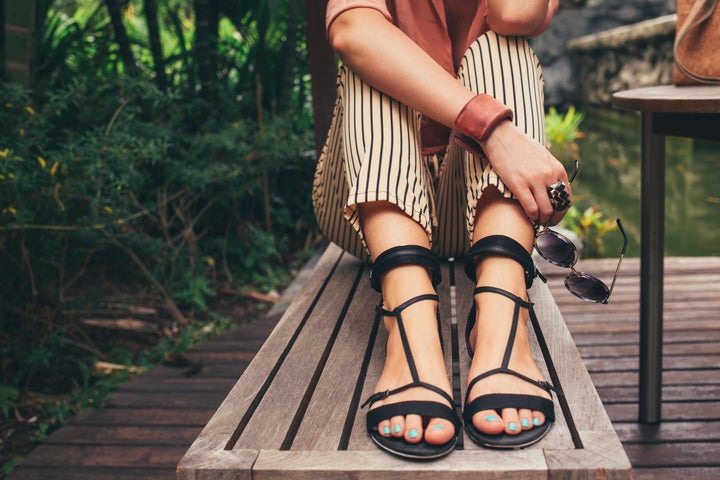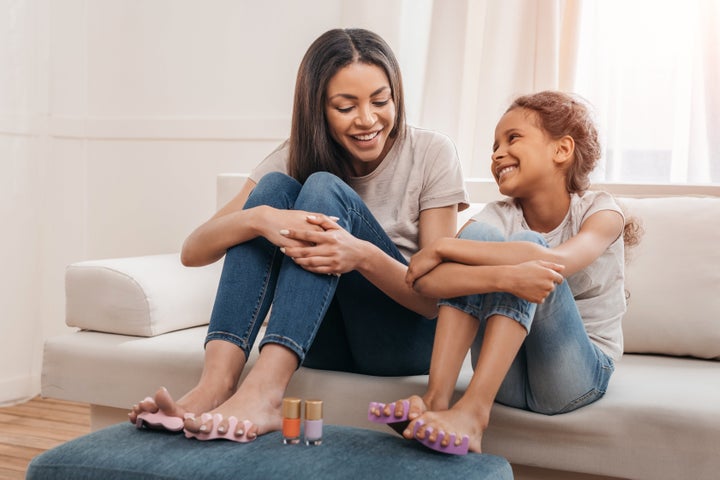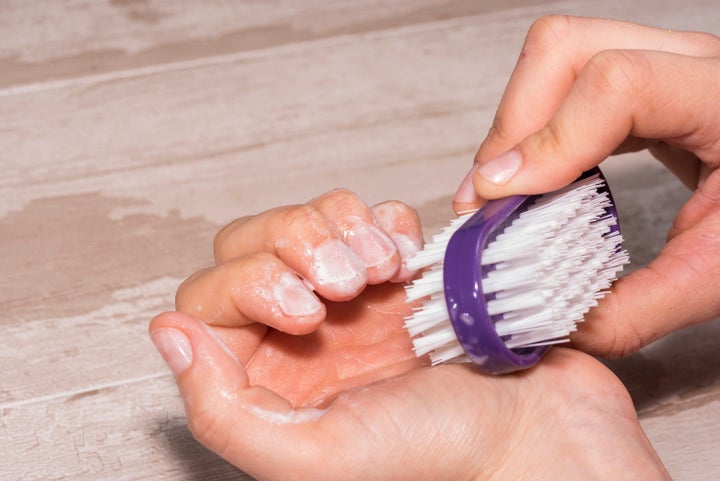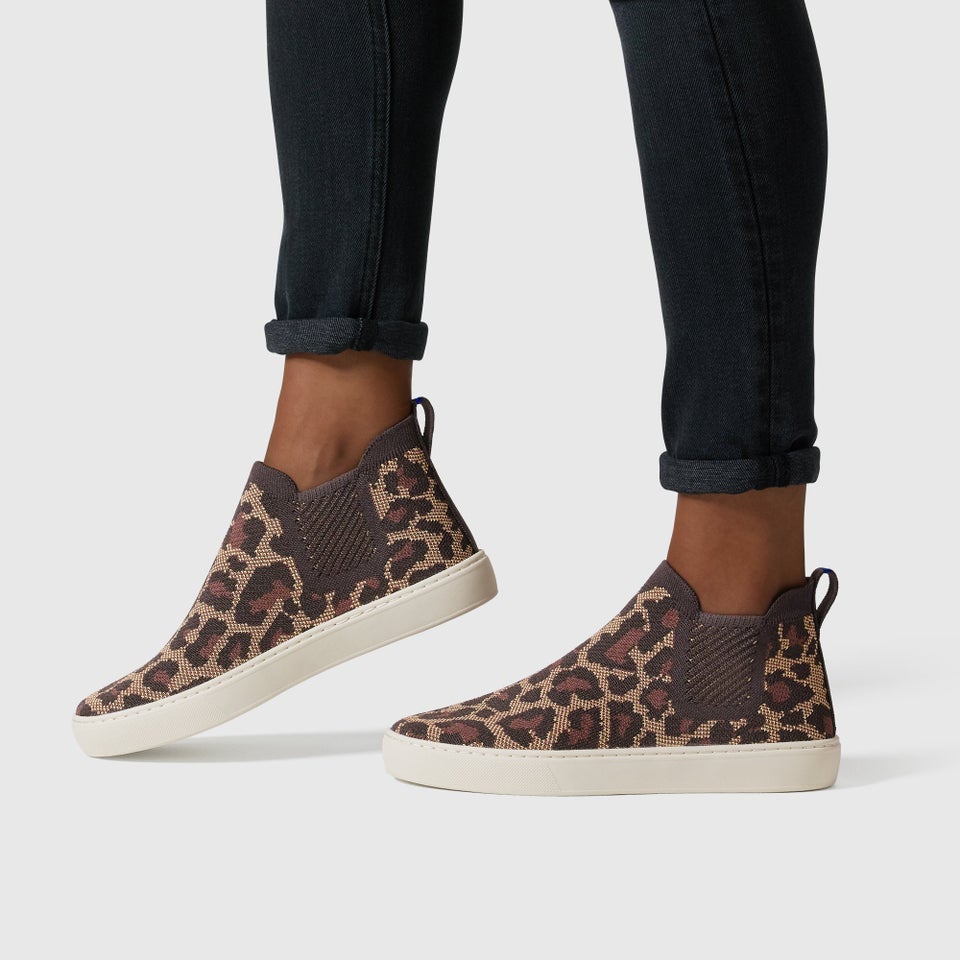
With summer just over a month away, it’s time to get your feet ready for sandal season.
We know it can be a little daunting to let your feet see the light of day ― or to let other people see your feet ― especially after they’ve been confined to thick socks and heavy boots, accumulating dead skin and forming calluses. It happens to all of us. (Neve Campbell, who once reportedly said she had “the ugliest feet in the world,” would understand.)
If you ask us, prepping your feet for sandals is really just another form of self-care. If you spend time taking care of your face and hair, why not your feet?
“The ideal thing,” according to Jane MacColla, founder of Hortūs Nailworks in New York, “is to maintain your feet all year round. But that doesn’t happen much.”
MacColla, as well as Amy Ling Lin, owner of Sundays nontoxic nail studio in New York, and dermatologist Angela Lamb, director of the Westside Mount Sinai Dermatology Faculty Practice in New York, told HuffPost how to care for your feet and keeping them looking good (yes, feet can look good!) all summer long.
Sometimes, you’ve just gotta let the professionals help you out.
If you aren’t sure where to start with your feet or if you’d rather leave them in the hands of professionals, getting a pedicure is perhaps the most obvious solution for bringing your winter-afflicted feet into summer.
MacColla recommends pedicures about every two weeks, but noted that some of her clients come in on a weekly basis. Ling Lin suggests a pedicure every two to three weeks. Both women agree, however, that everyone is different.
One thing to note, Ling Lin said, is if you’re someone who often goes to the beach and spends time in the sun, your feet might get a little drier. In that case, she recommends getting pedicure treatments that offer deep hydration to repair the skin.

You don’t always need to go to the salon.
If you’re in the camp of people who rarely (or never) get a pedicure, there are some things you can do at home to maintain your feet all year round.
Ling Lin said her go-to method is to soak her feet at home using a combination of warm water and various essential oils, such as peppermint or lavender, to soften the skin and to promote relaxation. You can also use some sort of scrub or file to get rid of dead skin on your own, she said, adding that she soaks her feet every other day.
You should also be moisturizing your feet, MacColla noted, just as you would the rest of your body after a bath or shower.
One of her favorite tools is a nail brush. “I love the nail brush,” she said. “It’s wonderful for your toes and your heels, the balls of your feet.”
[Use it] at the end of a bath, or during your bath or shower, when your skin’s softer, and then moisturize,” MacColla advised. “It’s the last thing you do before you go to bed, and it’s a really wonderful way of maintaining after treatment.”
Nail brushes, MacColla noted, are also great for cleaning up your cuticles.
“You would be surprised how much that tool can help remove that and clean up your toes a little bit,” she said.

Caustic chemicals aren’t always the answer.
Many people’s feet have dry, callused skin that has thickened or hardened from excess friction. There’s nothing wrong with calluses, but they can be a little unsightly, and some people prefer to get rid of them ahead of sandal season.
There are a couple ways to go about this, one being chemical removal. You may have heard about something called Baby Foot, which is essentially like a chemical peel for your feet. The product uses lactic, salicylic, glycolic and citric acids to break down the top layer of skin on your feet, which then peels off and leaves you with soft, baby-like feet (hence the name).
Some salons also use chemicals to remove calluses during pedicures ― but while they do give you soft feet, they can be quite harsh.
“Most acid products are actually quite harmful to the skin,” Ling Lin told HuffPost. [They do] remove [calluses], but it’s not the best solution.”
MacColla agreed with Ling Lin, noting that she isn’t a big fan of acid-based removal products either, as she’s found them to be quite drying.
“I think a lot of salons use those caustic chemicals where they wrap your feet in saran wrap and they’ve got gloves on and it’s really strong,” she said. “The thing I don’t like about [them] is you’re really not targeting as needed. It’s sort of a blanket solution.”
Lamb, on the other hand, told HuffPost she “loves these products” and said, “If you see improvement and no irritation, continue.” She wouldn’t recommend applying acid-based products for calluses more than twice a week (max), though.
Both Ling Lin and Maccolla said they prefer manual callus removal, using scrubs and a foot file to soften the skin. Both of their salons remove calluses and dead skin manually, not with chemicals.
What’s nice about removing the dry or dead skin manually, MacColla said, is that you can really focus on the areas that need the extra care, as opposed to covering the entire foot in a chemical solution.
“You don’t want to do too much or get overly aggressive with what you need, because you need calluses,” she said. “They protect your feet, and when you go overboard, your skin tries to compensate by building more skin, it gets really sensitive.”
It’s also important to note that you might not be able to get rid of all the dead skin you’ve built up over months in just one go. Whether you’re getting a professional pedicure or scraping at home, it may take some time to get your feet looking the way you want them to.
“The instinct is sometimes to over-exfoliate and scrub too hard which can actually aggravate the skin and cause it to produce more skin to compensate,” Lamb said.
So, as long as you’re taking care of your feet at home and frequently filing your calluses (but not too much ― you don’t want to be left with raw skin), you should be able to keep your skin soft and smooth, Ling Lin said.

Treat blisters with care.
One of the worst parts about wearing sandals for the first time after months of closed shoes is having to deal with blisters. Whether you’re sporting brand new shoes for the season or a pair you’ve already broken in, your feet still might not be used to them.
Getting blisters when you start wearing sandals again is “not abnormal,” MacColla said. “I think you do have to allow yourself a little bit of time breaking into things, so maybe you’re not wearing those sandals for eight hours. I do find that that’s very helpful.”
Then there’s the added factor of heat, which can cause feet to expand in your shoes. Hence, the inevitable blisters.
MacColla suggested soaking feet in a bath of warm water and Epsom salt to bring a little bit of relief, especially if you’ve been standing or walking around all day.
“Just give them a break at the end of the day. I do find that in the morning they’re very thankful,” she said, adding that a “little bit of a massage” couldn’t hurt.
Lamb recommended gel blister pads, which are often called hydrocolloid dressings, as “they are nice to provide cushion while allowing the blister to heal,” she said.
You also want to make sure you’re keeping blisters and the surrounding area clean and covered, Lamb said. And to be on the safe side, both MacColla and Ling Lin suggested avoiding a pedicure if you have full blisters on your feet that look ready to pop, as you don’t want to risk any potential infections.
If you’re looking to prevent blisters, our blister-prone editor Kristen Aiken swears by PreHeels, a spray that creates a barrier on the skin to block friction and stop blisters from forming. You could also use some trusty Moleskin padded stickers.
Whether you’re taking care of your feet for health or aesthetic reasons, just remember to treat them with care.
